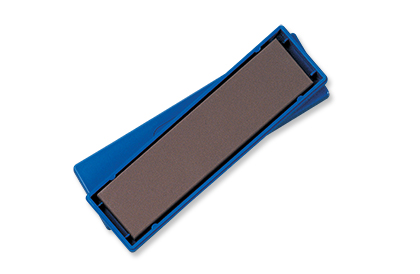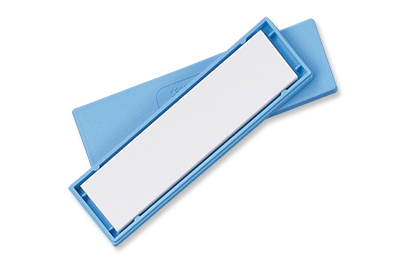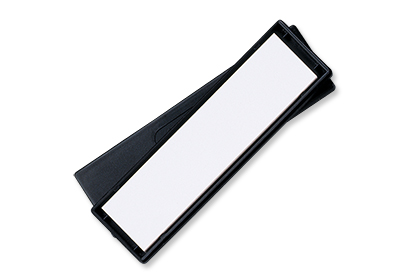Results 1 to 10 of 23
Hybrid View
-
11-20-2010, 04:15 PM #1
 I didn't realize how important FLAT is to a hone!
I didn't realize how important FLAT is to a hone!
Flat!
I have three ceramic hones from Spyderco for honing my straight razor. The medium, fine, and ultra-fine.



I've honed my Dovo Special tortoiseshell 5/8 round nose straight razor three times with these hones, as they came from the manufacturer. I was able to get a usable shave, but it just wasn't what I remember that razor feeling like when it was new.
I remember reading on the forums about lapping the hones to get them flat. So, how does one lap a ceramic hone? That stuff is hard.
I wanted something a bit more aggressive than that medium hone to set an initial bevel on my razor, so I bought an EZE Lap 3" x 8" Fine/Medium (800/400) dual grit diamond hone for that task:

It occurred to me I could use that to lap my ceramic hones, too. So that's what I did. (This voided the warranty on my hones, I realize) Plenty of water, and went to it on the 400 grit side. The medium hone flattened the quickest. The fine ceramic hone took an hour and several hundred laps to flatten. The ultra fine took about fifteen minutes.
It was pretty easy to see the high spots and the low spots as I was lapping. Since I had used these hones, there was steel deposited on the high spots and to a lesser degree, the low spots. On the diamond plate, the high spots ground off to be perfectly white, making it easy to see how far I had to go.
I was dubious how important the flatness of the hones is for honing a straight razor. I really figured they should be fairly usable and competent from the manufacturer.
Not so. At least not with these Sypderco ceramic hones.
While I was lapping, for comparative feel, I made a few strokes on the hone with my straight razor (no tape on the spine), just to see how it felt and sounded. Wow, you can sure tell the difference when the hone is flat!
The entire edge of the razor is in full contact with the entire face of the hone over the entire stroke. It feels almost sticky, the drag is so smooth and consistent.
The dark pattern of steel left on the hone is now left across the whole face of the hone.
I had a quick look at the edge under my stereo microscope at 35x, and the result from just testing the hones was astounding! Easily the most precise and smooth edge I have produced to date, and I wasn't trying for a finished edge, remember. I was just testing the hones.
This evening I will run the razor through a progression, and have a shave with it in the morning. The shave I had with it this morning was acceptable, but not great. I am most anxious to see how tomorrow's compares.[/quote]Last edited by TheMetatron; 11-20-2010 at 04:21 PM.
-
11-20-2010, 04:27 PM #2illegitimum non carborundum



- Join Date
- Jan 2008
- Location
- Rochester, MN
- Posts
- 11,544
- Blog Entries
- 1
Thanked: 3795
If you lap the Spydercos you alter their apparent "grit" size. The only difference between the F and UF hones is the surface finish, which is altered by the lapping.
-
11-20-2010, 04:40 PM #3

Personally, I'm not as big on the mathematically flat concept as others. I think honing is in the hands, and while I'm not going around recommending people don't lap their hones, I don't personally worry much about it.
Unless there is a major unevenness, I don't bother...
-
11-20-2010, 04:44 PM #4illegitimum non carborundum



- Join Date
- Jan 2008
- Location
- Rochester, MN
- Posts
- 11,544
- Blog Entries
- 1
Thanked: 3795
-
11-20-2010, 04:55 PM #5
-
11-20-2010, 05:07 PM #6

The Spydercos have an absolutely different feel to them once lapped.
On a brand new UF, I can definitely feel the 'swirls' of the surface finish
on the razor, but it still does the job. A lapped UF feels like glass.
Lapping these hones, to me, is about the surface finish, not the flatness.
- Scott
-
11-20-2010, 06:40 PM #7
 Not so sure about the grit being on the finish...
Not so sure about the grit being on the finish...
After lapping the fine and ultra-fine stones on the 400 grit diamond plate, their finish is definitely still different. I can also see the difference with my high power microscope.
The little scrap of paper information sheet that came with them said they're made from high alumina ceramic, formed when alumina particles (synthetic sapphires) are mixed with a ceramic bonding agent, then fired to make the final shape. I'd think it is the size of those alumina particles that are determining the grit of the fired ceramic.
As for the flatness, it is the flatness across the stone that I was after, not so much the flatness from end to end.
Before I lapped them, both the fine and ultra fine had clear high spots that were the only places on the hone that were removing metal from the edge. This was evident by the dark black lines that showed those high spots.
Now, they get a uniform grey from the removed steel, showing no high spots. I think this is the main reason the feel is so different. The full blade edge is in contact with the full face of the stone over the entire stroke. This polished the edge much, much faster than the unlapped hones. I'm thinking this must be because of the more constant contact with the hone.
But, the proof will be in the shave tomorrow morning. I gave it fifty laps on the linen side of my Illinois Strop Company 127 strop, and another fifty on the leather side this evening. Beard hairs only grow so fast...
-
12-08-2010, 05:47 AM #8Silky Smooth

- Join Date
- Sep 2008
- Location
- Southern California
- Posts
- 798
Thanked: 154


 LinkBack URL
LinkBack URL About LinkBacks
About LinkBacks






 Reply With Quote
Reply With Quote



